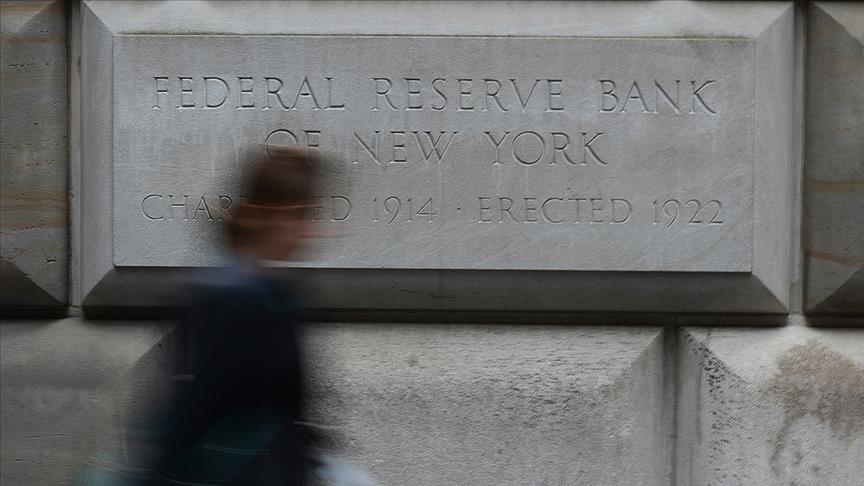ANKARA
The US Federal Reserve’s monetary policy is expected to be restrictive through the end of 2025, according to Ryan Sweet, an economist at Moody’s Analytics.
The Fed on Wednesday raised its benchmark interest rate by 75 basis points for the third consecutive time to fight record inflation, carrying the federal funds rate to the 3.00%-3.25% range, and also raised its terminal rate above 4% for 2022 and 2023.
“If there was any doubt that the Federal Reserve was serious about taming inflation, it should be gone after the September meeting of the Federal Open Market Committee (FOMC), as they hiked the target range for the fed funds rate by 75 basis points and signaled a noticeably higher terminal rate than previously thought,” Sweet told Anadolu Agency via email.
The terminal rate, the peak spot where the federal funds rate is expected to climb before it is trimmed, was raised to 4.4% for 2022 from an estimate in June of 3.4%.
That rate is projected at 4.6% for 2023, up from 3.8%, according to the Fed’s dot plot — a chart that records each FOMC member’s projection for its key short-term interest rate.
Fed Chair Jerome Powell said in a press conference after the meeting that median projections for year-end suggest a total rate increase of another 125 basis points, or 100 basis points, by the end of the year. He noted, however, that the FOMC did not vote on that decision at this meeting.
“There were major shifts in the dot plot, as it now has the median projection for the fed funds rate at 4.4% at the end of this year with only two meetings remaining, implying a 75 basis point hike in November and a 50 basis point increase in December,” Sweet said.
“The Fed expects to cut rates in 2024, ending the year at 3.9% and 2.9% in 2025. There were no changes to the central bank’s estimate of the neutral fed funds rate, which remained at 2.5%. Therefore, monetary policy will be restrictive through the end of 2025,” he added.
‘Growth to be below economy’s potential to reduce inflation’
The personal consumption expenditures (PCE) price index, the Fed’s preferred inflation indicator, showed an annual gain of 6.3% in July. The central bank expects PCE inflation to return to its target of 2% in 2025, according to the projections.
While the Fed has prioritized lowering inflation over economic growth, there still remains the risk of a recession in the world’s biggest economy.
“Reducing inflation is likely to require a sustained period of below-trend (economic) growth, and it will very likely be some softening of labor market conditions,” said Chair Powell.
“We have got to get inflation behind us. I wish there was a painless way to do that, (but) there isn’t. What we need to do is get (interest) rates up to the point where we put meaningful downward pressure on inflation…We have to get supply and demand back into alignment, and the way we do that is by slowing the economy,” he added.
The Fed now expects the American economy to grow 0.2% this year, down from its previous forecast of 1.7% growth made in June. The growth estimate for 2023 was also lowered to 1.2%, down from a projection of 1.7%.
Sweet emphasized that there were some sizable downward revisions to the Fed’s forecasts for the gross domestic product (GDP) and added: “Growth over the next couple of years will be below their estimate of the economy’s potential of 1.8%, which is necessary to reduce inflation.”
The unemployment rate is also expected to climb to 3.8% in 2022, up from an expectation of 3.7% made in June, while the rate is forecast at 4.4% in 2023, up from a previous estimate of 3.9%, according to the Fed’s projections.
“The Fed revised higher its forecast for the unemployment rate next year and anticipates it will rise. Historically, an increase in the unemployment rate of this magnitude over a year has been followed by a recession,” Sweet concluded.
The Federal Reserve Bank of Atlanta’s GDP model showed on July 1 that the US economy is already in a recession, while the latest model estimate for real GDP growth in the third quarter was 0.5% on Sept. 15, down from 1.3% on Sept. 9.
The US economy contracted at an annual rate of 0.6% in the second quarter, according to the Commerce Department’s second reading made on Aug. 25, which followed an annual 1.6% contraction posted in the first quarter.
While GDP is one of many factors that the US National Bureau of Economic Research considers when assessing if the American economy is in a recession, there is also a “technical recession” definition, which is referred to when there are at least two consecutive quarters of negative growth in real GDP.

